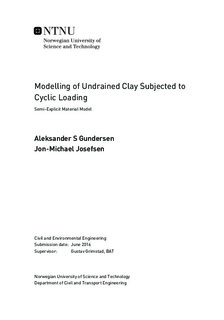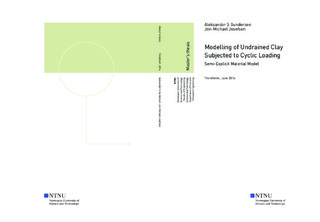| dc.description.abstract | A material model, based on total stresses, has been developed to represent the undrained cyclic behavior of clay for finite element analyses. The material be- havior is split into an average- and a cyclic part, formulated as two material models with a coupling. The cyclic loading is, for the model, assumed to be defined in terms of forces and have a frequency within the "cyclic" range (≈ 0.1 Hz), which implies that mass and damping considerations are omitted.
Degradation of the maximum average shear stress and the cyclic shear stiffness is accounted for using the cyclic shear strain accumulation principle. The re- sulting accumulation of plastic shear strains is a byproduct of the degradation of maximum average shear stress.
The average model and the cyclic model are verified individually by Plaxis simu- lations with satisfactory results. A bearing capacity problem was simulated with the average model and compared directly to a simulation done by an acknowl- edged undrained model. The average model exhibited the expected behavior and the authors believe it can be used in similar boundary value problems when used with care.
The cyclic model was used in a cyclic direct simple shear simulation with no average shear stresses. The simulation result was compared directly to a similar calculation and the conclusion is that the cyclic model is able to represent the undrained cyclic behavior in a direct simple shear test. The interaction between the average and the cyclic model was tested in another direct simple shear test. The results obtained was satisfying and prove that the interaction is working as desired.
Another objective was to compare the presented model directly to results from model tests of a gravity base structure. Due to time limitations and the complex- ity of the problem, only a hypothetical analysis is undertaken. Results indicate further investigation is necessary to confirm the applicability of the soil model on gravity base structures. | |

